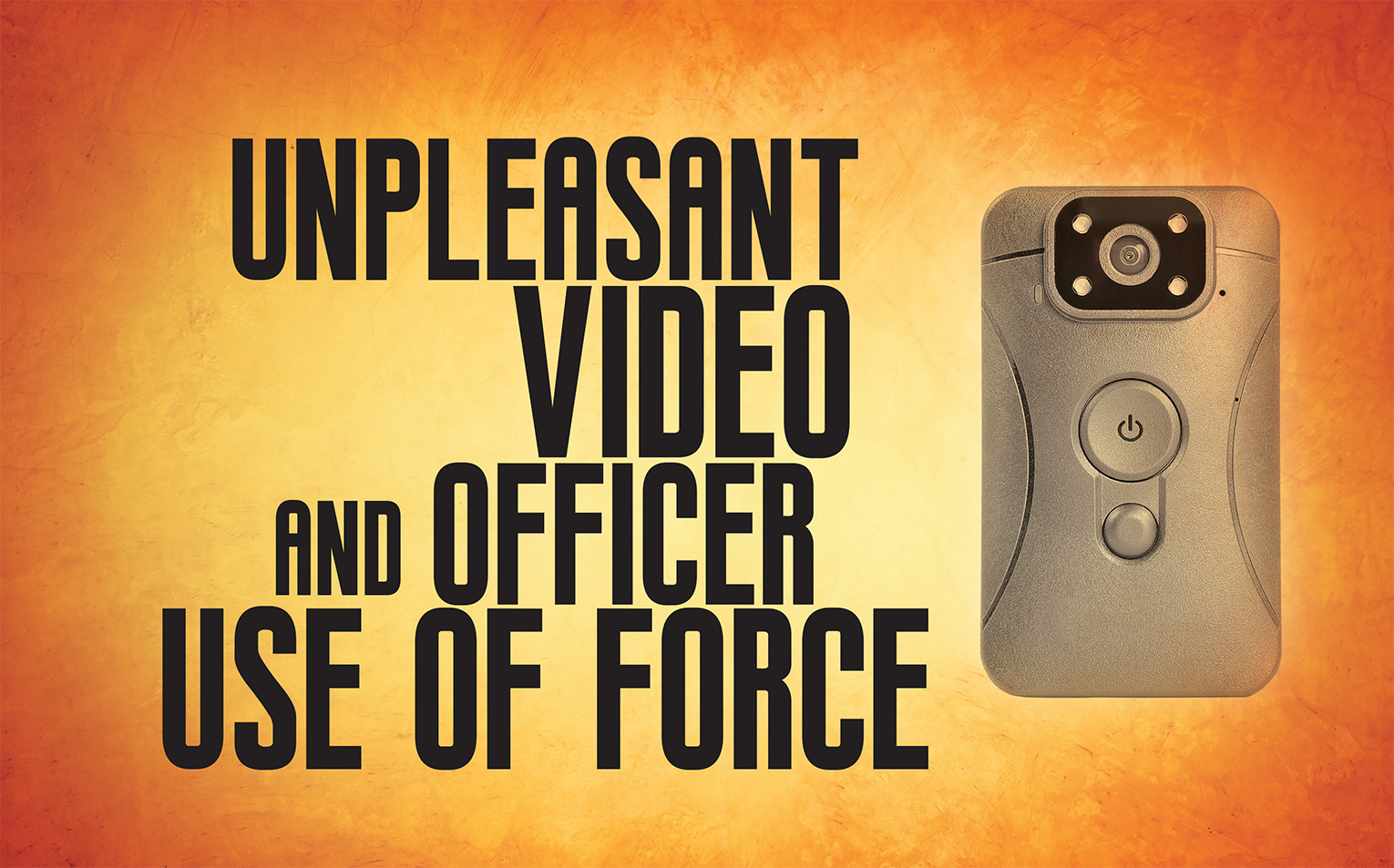

LVPPA Director
I have had the opportunity to review videos of law enforcement uses of force on multiple occasions over the years in my duties as a police officer. I have been a DTI with LVMPD for years, and my multi-year stint at AOST increased the tempo of seeing and evaluating use-of-force incidents involving LVMPD officers and those from other departments. In addition to my professional duties, effective use of force is a personal passion of mine, and I regularly seek not just to evaluate the lawfulness of an application of force, but also to find more effective ways to train for these events and improve professional performance.
As I have evaluated footage of use-of-force events in recent years, I have often been given a warning prior to watching a video. The warning often goes something like this: “Brace yourself,” or “This is the worst video ever.” I might hear something along the lines of “You will not believe this video. This is so bad.”
Sufficiently warned, I brace myself for the unlawful and crazy video that must be coming. I watch the video and think, no, that is actually not the craziest video I have ever seen. It is a video of police work. It is often ugly. In almost every video I watch, there are mistakes and things the officer could do better. But overwhelmingly, it is video of an officer doing work that I have done for almost 20 years. The only difference is that it routinely gets caught on camera now. The video is often uncomfortable to watch, but I believe much of that discomfort simply comes from watching a video of what our job requires.
From a human perspective, it should be distasteful to use force and violence against other humans. But when you are confronted with what you reasonably believe to be a threat, defending against that threat can overcome the natural aversion that good people have to using force or violence, and the focus becomes defending yourself. The one in the fight is trying to do what must be done, and since police officers rarely use any force, they are relying on training and taking action to deal with the situation they are in. The ones watching the video did not have to use force. They did not suffer any of the human effects of a stimulus and elevated heart rate. They compare the actions on a video to what is written in a lesson plan, and they lose confidence in the actions caught on film. This is yet another shameless plug for officers to train. Want to look better on tape? Train a lot.
As I stated earlier, these videos of officers using force on suspects can be uncomfortable to watch. As police officers, we are asked to do hard things. A male officer using force on a female suspect can be distasteful, but that doesn’t make it wrong. I have never used force on someone in my personal life because they didn’t obey something I told them to do. Outside training or on-the-job uses of force, I have not used physical force against another person in the street in the time I have been a police officer. It is hard to watch these physical confrontations on video, but just because they are hard to watch, and the officer might have areas to improve on, that doesn’t make them wrong.
The Legal Standard
It is a huge error to judge the legitimacy of a use of force solely from watching a video of an event. I was recently reviewing a video message on reviewing officer uses of force caught on tape by renowned human-performance and use-of-force expert Dr. Timothy Lee. He related that he had recently addressed a group of police chiefs at a training conference, where he stated that the absolute worst mistake an investigator could make is to judge a use of force just by watching a video. Dr. Lee teaches that those judging uses of force should not form a strong opinion prior to talking to an officer and evaluating all evidence, including video of the event.
Why is the officer’s reasonable perspective even more important than what a video shows when evaluating these events? The primary reason is the human factors that can affect not just the officer’s physical performance, but also their actual perspective on the threat they were dealing with. Use-of-force case law actually understands these human factors, and that is the lens through which courts evaluate these events. Case law requires the officer to choose a reasonable force option in response to a threat they reasonably perceive. This is another place where I often see those “evaluating” fall short. They will ask why the officer didn’t choose option A instead of option B, because in the evaluator’s opinion A would have been better. The truth is that it actually doesn’t matter if you “prefer” option A. As long as option B is reasonable and lawful, it doesn’t matter that you would do something different. The appropriateness of a use of force is not judged purely by its effectiveness. An officer may pick a lawful and reasonable force option and on film it may fail, look ugly and still be OK. Conversely, it may work extremely well and dominate the suspect. That doesn’t make it wrong either.
As we consider officer perception, remember that it can be factually incorrect but the use of force completely justified. The officer’s recollection can actually be proven wrong by video of the event and the officer’s actions can still be justified. Why? The video has no perception. It feels nothing. It simply captures an event, and not always accurately. How would you possibly understand an officer’s perception (a legal requirement to find a use of force lawful or not) if you didn’t reserve judgment until you considered the officer’s perspective at the time force was used? To watch a video and form a conclusion that you will then attempt to prove is amateur hour and flies in the face of best practices regarding use-of-force investigations.
The Limitations of Video
A video is an effective piece of evidence. It can document who was there, that force was used and specific details of the event, and it should be preserved and evaluated. However, if you make a determination as to whether the event is justified or not simply based on the video, you are acting like an uninformed civilian who watches a “cop video” on the news or online and condemns the officer and their actions despite having limited information about what really occurred from the officer’s perspective. Video is key evidence for sure, but it is a piece of the puzzle. To get a clear picture of what the puzzle creates, consider all of the pieces.
It is vital to understand that video can have some inherent issues. What you see is not always what really happened, especially for the officer in the fight. The camera captures what it captures, from the angle where it happens to be pointed, at varying levels of accuracy based on the quality of the camera. Without turning this into a very technical piece that may put you all to sleep, the camera can actually miss key movement and frames depending on its capabilities. The camera could also have capabilities to see more clearly in the dark than the human eye, thus failing to capture the event as the officer saw it. A high-end camera may allow the action to be broken down in vivid detail, in slow motion, even frame by frame, to show “what truly happened.” It is important to realize the officer did not have the ability to see any of these clarifying factors, and was unable to slow down the action or even pause it when it actually occurred.
 The Human Factors
The Human Factors
If the camera captures an event as it happened, there are a number of reasons why an officer may have seen the event differently or missed “key” aspects during the fight. The officer’s attention is often divided between the suspect and other people or threat areas. The officer may be tired, scared, injured or overwhelmed. The officer’s perception as all these things play out is influenced in the moment by training and prior experiences. Those who have more training and actual experience in violent confrontations tend to have better perception of threat levels and decision making. (Here is another plug for training on a regular basis.) The camera suffers from none of these factors. Courts understand these human factors and take them into account. As this is the legal standard for justifying an actual use of force, we should account for them as well.
In considering whether a use of force is justified, the human factors carry far more weight than video or even physical evidence after the fact. For example, let’s say an officer reasonably believes a suspect is armed, and reasonably believes that the suspect’s behavior is aggravated aggressive in nature and that the suspect is displaying an intent to harm. At the moment the officer decides this and reasonably responds with lethal force, it does not matter if a complete investigation shows that the suspect was not really armed or that their “weapon” was a replica. Going back to my original assertions, this can be hard to watch on video and may become more uncomfortable after the fact, realizing that the suspect is being engaged lethally despite not actually being armed or being armed with a fake weapon (or a phone held in a manner resembling a gun, for instance).
In a non-lethal physical confrontation, an officer could be dealing with a suspect showing aggressive behavior and an intent to harm officers by kicking at them, and the officer might counter those attempts with force. At times when this happens, those looking into this event will judge the effectiveness of the kicks and say the officer was heavy-handed despite choosing an arrest and control measure (like immobilizing the suspect by pushing them over an object or into a wall and then holding them there) against someone using aggressive resistance.
Judging the Amount of Force
At times I have heard comments, based on watching the video, that the officer is being too heavy-handed against a physically resistive suspect because the officer physically dominates the suspect and overcomes the resistance. Those watching will say the suspect isn’t even resisting, or that the officer should use “less force,” even though the force option the officer chose was appropriate. Some will even specify a certain percentage less, as though by watching a video they can accurately say the suspect was at 25% resistance and the officer could do what they were doing, but they were at 93% force and should have been at 33% because that would have overcome the resistance.
It is nearly impossible during a struggle to know what degree of force application will work. As an advanced DTI, when I teach DT sessions I focus on students knowing proper use-of-force case law and policy and picking a reasonable force option during a confrontation. I don’t say, “OK, next five reps at 30% … Now let’s move to 60%, and finally 100%.” It is emphasized that a reasonable force option be chosen at all times. Certainly, pre-force implementation factors like age, size, known training, armed versus unarmed, etc., are all considered. But once the physical confrontation begins, it is very hard to do any kind of math or to know exactly what it will take to overcome the suspect’s resistance. The biggest indication that I used an appropriate amount of force is that the suspect’s resistance ceases.
While it can be very challenging to know the right amount of force I need to use while I am in the fight, it is almost impossible to do so by watching a video. You have no idea, once they grab each other and start struggling, how much or little effort the suspect and the officer are using. Often these videos will show the officer pushing, pushing, pushing, and the suspect suddenly being overcome and giving out due to the pressure. This often happens in seconds during the fight, and the officer feels tension and resistance until suddenly they overcome that resistance. If the officer overcomes the resistance and pins the suspect in a trained manner to assume control, a review of video alone does not allow me to say whether the officer pushed too much or not. An example of this is unknowledgeable fans watching an MMA fight where two fighters are against the cage and complaining that “they aren’t doing anything” or being surprised when the fighters are tired. To think that you can watch a video and understand the pressure or force being used by either party shows that you don’t regularly train in such things. A key part of a reasonable interpretation is training and experience. Be a pro as you access these things.
The Ugly Reality
Using force on humans should not be easy or enjoyable. It is often ugly and uncomfortable. My goal is always compliance and de-escalation, but the suspect ultimately decides whether force is even needed or if de-escalation through non-physical means will be successful. To blame an officer because de-escalation “didn’t work” or say that the officer should have done more de-escalation and it would have worked (How would you know? It already failed) is very curious to me. However, that will be for another article.
“There is no nice way to arrest a potentially dangerous, combative suspect,” wrote Charles H. Webb, Ph.D. “The police are our bodyguards: our hired fists, batons and guns. We pay them to do the dirty work of protecting us. The work we’re too afraid, unskilled or too civilized to do ourselves. We expect to keep the bad guys out of our business, out of our cars, out of our houses, out of our faces. We just don’t want to see how it’s done.”
Dr. Webb got it right. We embrace this quote and put it in the curriculum in academies to teach new guys what they are up against. We put it on shirts. We quote it to show that civilians “don’t understand us.” Then we watch a video and judge the event because the video makes us say, “Man, that is tough to watch.”
These videos often are not the “worst I have ever seen,” but they can be uncomfortable to watch. They are typically just police work, and they are ugly, they even contain mistakes, but they are simply capturing how this is done, and how it has always been done.
Over my years of policing we have improved, and we will continue to do so. But please remember, as you review and “judge” one another’s performance: The bad guy is usually to blame for the uncomfortable video you are watching and the uncomfortable actions the cop on the video is being forced to do. At the end of the day, there is no easy way to arrest a dangerous and combative suspect. Stop looking for one.

